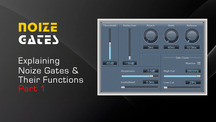Following on from our three part post on Compression, we have decided to continue by explaining the basics of Noise Gates and in which situations they are best suited.
The Noise Gate was originally designed to help eliminate hiss, rumble and other unwanted recording artifacts, it has quite a few creative uses once you understand the main controls you can easily start incorporating gates into your own productions.
In this first tutorial, we’ll take a closer look at the underlying principles that govern this type of effect.
The aim of a pure noise gate is to mute signals with low volume. Most gates are also able to close just partially, providing a set attenuation as opposed to muting the signal completely.
Below are two traditional situations where a noise gate might be used:
For recording applications
Gates are used to eliminate background noise when the instrument or voice is not generating a signal (during pauses, and just before the song starts and after the song has just finished), and this is beneficial for getting rid of any unwanted hiss that you may not hear. This technique can also be useful when recording podcasts (for ducking music out when vocals are introduced), much like the talkback function in studios.
For sound reinforcement applications
Gates are not as necessary in a loud stage situation, since background noise is not such a big problem once the show is taking place. In this case gates tend to be used more with the idea of stopping sounds from leaking into a microphone that is not being used. For instance, the bass drum mic would only be active during bass drum hits and gated (closed), while the snare hits and vice versa.
It is important to understand that gates do not eliminate the noise. They just hide it by attenuating it when it is most obvious (during pauses), and let it through when it is mixed with the signal.
Our next post will look at some of a gate's standard controls, and we'll then follow with some other ways you might put a gate to work in your studio.
Original Source - www.doctorproaudio.com












